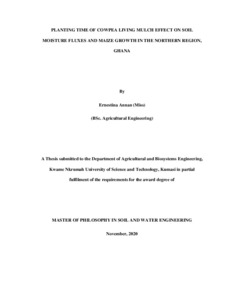| dc.contributor.author | Annan, E. |
| dc.date.accessioned | 2022-06-22T09:55:06Z |
| dc.date.available | 2022-06-22T09:55:06Z |
| dc.date.issued | 2020-11 |
| dc.identifier.citation | Annan, E. (2020). Planting time of cowpea living mulch effect on soil moisture fluxes and maize growth in the northern region Ghana. Accra, Ghana: University of Ghana, (107 p.). |
| dc.identifier.uri | https://hdl.handle.net/20.500.12478/7524 |
| dc.description.abstract | The Northern Region of Ghana is vulnerable to weather variability especially uneven rainfall distribution patterns. This compromises soil moisture availability for optimal crop growth. The objective of this study was to assess the effect of cowpea living mulch as a soil and water conservation measure on soil moisture fluxes and maize growth in the Northern Region of Ghana. Four different maize-cowpea intercrop systems were combined with three maize varieties in four different communities and their effect on soil available moisture content and maize growth as well as yield were monitored and analyzed. The cowpea living mulch as well as maize varieties had effect on soil available moisture and maize growth. The presence of cowpea living mulch resulted in a maximum increase in available moisture of 8.81 %, its effects however differed with cowpea planting time. The system where cowpea was planted one week after planting maize yielded the highest improvement in available moisture content. Abontem maize also had higher available soil moisture conserved than the other varieties. The differences in effect of the cowpea living mulch systems on maize growth and grain yield was however not significant except for stem girth which was significantly bigger under the sole maize compared to the other three systems. Yield of maize increased with higher moisture availability. Highest maize grain yield was 3.13 t/ha under NLM, followed by 3.09 t/ha and 3.05 t/ha under A2WK and A1WK respectively. The results indicate that cowpea living mulch system is beneficial in conserving soil water which improves crop yield, and therefore should be encouraged in ensuring sustainable land use and management for maize production especially in arid and semi-arid areas. |
| dc.format.extent | 107 p. |
| dc.language.iso | en |
| dc.publisher | University of Ghana |
| dc.subject | Ghana |
| dc.subject | Maize |
| dc.subject | Cowpeas |
| dc.subject | Intercropping |
| dc.subject | Climate Change |
| dc.subject | Farming Systems |
| dc.subject | Varieties |
| dc.subject | Yields |
| dc.subject | Grain Legumes |
| dc.title | Planting time of cowpea living mulch effect on soil moisture fluxes and maize growth in the northern region Ghana |
| dc.type | Thesis |
| cg.contributor.crp | Grain Legumes |
| cg.contributor.affiliation | University of Ghana |
| cg.contributor.affiliation | International Institute of Tropical Agriculture |
| cg.coverage.region | Africa |
| cg.coverage.region | West Africa |
| cg.coverage.country | Ghana |
| cg.coverage.hub | Headquarters and Western Africa Hub |
| cg.identifier.bibtexciteid | ANNAN:2020 |
| cg.authorship.types | CGIAR and developing country institute |
| cg.iitasubject | Agronomy |
| cg.iitasubject | Climate Change |
| cg.iitasubject | Cowpea |
| cg.iitasubject | Farming Systems |
| cg.iitasubject | Food Security |
| cg.iitasubject | Grain Legumes |
| cg.iitasubject | Maize |
| cg.iitasubject | Plant Breeding |
| cg.iitasubject | Plant Production |
| cg.notes | IITA supervisor: Dr. Kizito, F. |
| cg.publicationplace | Accra, Ghana |
| cg.accessibilitystatus | Limited Access |
| cg.reviewstatus | Internal Review |
| cg.usagerightslicense | Copyrighted; all rights reserved |
| cg.targetaudience | Scientists |
| cg.futureupdate.required | No |

